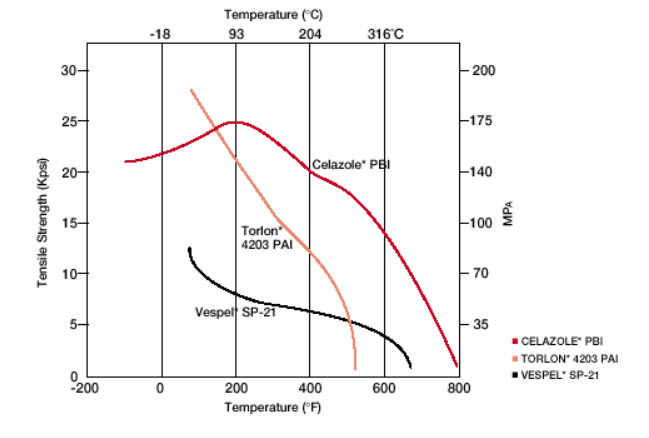Knowde Enhanced TDS
Identification & Functionality
- Polymer Name
- Technologies
- Product Families
Features & Benefits
- Labeling Claims
- Materials Features
- Product Overview
- Highest mechanical properties of any plastic above 400°F (204°C)
- Highest heat deflection temperature 800°F (427°C), with a continuous service capability of 750°F (399°C) in inert environments, or 650°F (343°C) in air with short term exposure potential to 1,000°F (538°C)
- Lowest coefficient of thermal expansion and highest compressive strength of all unfilled plastics.
Applications & Uses
- Applications
- Plastics & Elastomers End Uses
- Product Applications
- High Heat Insulator Bushings - Bushings used in hot runner plastic injection molds made of Duratron® CU60 PBI allow the plastic being molded to remain in melt as the part "freezes" in the cool mold. Bushings last longer and ease clean up since hot molten plastics do not stick to Duratron® CU60 PBI (Prior materials: Vespel® PI, Ceramic).
- Electrical Connectors - For an extra margin of safety, an aircraft engine manufacturer replaced connectors exposed to temperatures over 400°F (205°C) with Duratron® CU60 PBI (Prior material: Vespel® PI).
- Ball Valve Seats - Seats manufactured from Duratron® CU60 PBI excel in high-temperature fluid handling service (Prior material: Metal).
- Clamp Rings - Parts machined from Duratron® CU60 PBI for gas plasma etching equipment last longer than polyimide parts due to reduced high energy erosion rates. Because they need replacement less often, valuable production "uptime" is gained (Prior material: Vespel® PI).
Properties
- Color
- Mechanical Properties
- Thermal Properties
- Electrical Properties
- Miscellaneous Properties
| Value | Units | Test Method / Conditions | |
| Tensile Strength | 130 | MPa | ISO 527-1/-2 (7) |
| Tensile Strain (Elongation) at Break | 3 | % | ISO 527-1/-2 (7) |
| Tensile Modulus of Elasticity | 6000 | MPa | ISO 527-1/-2 (9) |
| Compressive Stress (1 / 2 / 5 % Nominal Strain) | 58/ 118 /280 | MPa | ISO 604 (10) |
| Charpy Impact Strength (Unnotched) | 20 | kJ/m² | ISO 179-1/1eU |
| Charpy Impact Strength (Notched) | 2.5 | kJ/m² | ISO 179-1/1eA |
| Flexural Strength | 160 | MPa | ISO 178 (12) |
| Hardness (14) | 125 | Rockwell M | ISO 2039-2 |
| Value | Units | Test Method / Conditions | |
| Glass Transition Temperature (DMA, Tan Delta) | 415 | °C | DMA |
| Thermal Conductivity (23°C) | 0.4 | W/(K.m) | — |
| Coefficient of Linear Thermal Expansion (23 - 60°C) | 25 | µm/(m.K) | — |
| Coefficient of Linear Thermal Expansion (23 - 100°C) | 25 | µm/(m.K) | — |
| Coefficient of Linear Thermal Expansion (min. 150°C) | 35 | µm/(m.K) | — |
| Heat Deflection Temperature (Method A: 1.8 MPa (264 PSI)) | 425 | °C | ISO 75-1/-2 |
| Continuous Allowable Service Temperature in Air (20.000 hrs) (3) | 310 | °C | — |
| Minimum Service Temperature (4) | -50 | °C | — |
| Flammability (3 mm) (5) | V-0 | — | UL 94 |
| Flammability (Oxygen Index) | 58 | % | ISO 4589-1/-2 |
| Value | Units | Test Method / Conditions | |
| Electric Strength | 28 | kV/mm | IEC 60243-1 (15) |
| Volume Resistivity | 100000000000000 | Ohm.cm | IEC 62631-3-1 |
| Surface Resistivity | 10000000000000 | Ohm/sq. | ANSI/ESD STM 11.11 |
| Dielectric Constant (1 MHz) | 3.2 | — | IEC 62631-2-1 |
| Value | Units | Test Method / Conditions | |
| Density | 1.3 | g/cm³ | ISO 1183-1 |
| Water Absorption (After 24h Immersion in Water of 23°C) | 0.74 | % | ISO 62 (16) |
| Water Absorption (At Saturation in Water of 23 °C) | 14 | % | — |
| Wear Rate | 3 | µm/km | ISO 7148-2 (18) |
| Dynamic Coefficient of Friction | 0.3 - 0.5 | — | ISO 7148-2 (18) |
| Limiting PV (0.1/1 m/s Cylindrical Sleeve Bearings) | 1.80/ 1.14 | Mpa.m/s | — |
Regulatory & Compliance
- Chemical Inventories
Technical Details & Test Data
- Comparative Tensile Strength Vs. Temperature

- Flexural Modulus Vs. Temperature

- Note
- Thermal Properties - The figures given for these properties are for the most part derived from raw material supplier data and other publications.
- (2) Values for this property are only given here for amorphous materials and for materials that do not show a melting temperature (PBI, PAI & PI). DMA settings, oscillation amplitude of 0.20 mm; a frequency of 1 Hz; heating rate of 2°C/min
- (3) Temperature resistance over a period of min. 20,000 hours. After this period of time, there is a decrease in tensile strength – measured at 23 °C – of about 50 % as compared with the original value. The temperature value given here is thus based on the thermal-oxidative degradation which takes place and causes a reduction in properties. Note, however, that the maximum allowable service temperature depends in many cases essentially on the duration and the magnitude of the mechanical stresses to which the material is subjected.
- (4) Impact strength decreasing with decreasing temperature, the minimum allowable service temperature is practically mainly determined by the extent to which the material is subjected to impact. The value given here is based on unfavorable impact conditions and may consequently not be considered as being the absolute practical limit.
- (5) These estimated ratings, derived from raw material supplier data and other publications, are not intended to reflect hazards presented by the material under actual fire conditions. There is no ‘UL File Number’ available for these stock shapes.
- Mechanical Properties - Most of the figures given for the mechanical properties are average values of tests run on dry test specimens machined out of rods 40-60 mm when available, else out of plate 10-20mm. All tests are done at room temperature (23° / 73°F)
- (7) Test speed: either 5 mm/min or 50 mm/min [chosen acc. to ISO 10350-1 as a function of the ductile behavior of the material (tough or brittle)] using type 1B tensile bars
- (8) Test speed: either 0.2"/min or 2"/min or [chosen as a function of the ductile behavior of the material (brittle or tough)] using Type 1 tensile bars
- (9) Test speed: 1 mm/min, using type 1B tensile bars
- (10) Test specimens: cylinders Ø 8 mm x 16 mm, test speed 1 mm/min
- (11) Test specimens: cylinders Ø 0.5" x 1", or square 0.5" x 1", test speed 0.05"/min
- (12) Test specimens: bars 4 mm (thickness) x 10 mm x 80 mm; test speed: 2 mm/min; span: 64 mm.
- (13) Test specimens: bars 0.25" (thickness) x 0.5" x 5"; test speed: 0.11"/min; span: 4"
- (14) Measured on 10 mm, 0.4" thick test specimens.
- (15) Electrode configuration: Ø 25 / Ø 75 mm coaxial cylinders; in transformer oil according to IEC 60296 ; 1 mm thick test specimens.
- (16) Measured on disks Ø 50 mm x 3 mm.
- (17) Measured on 1/8" thick x 2" diameter or square
- (18) Test procedure similar to Test Method A: “Pin-on-disk” as described in ISO 7148-2, Load 3MPa, sliding velocity= 0,33 m/s, mating plate steel Ra= 0.7-0.9 μm, tested at 23°C, 50%RH.
- (19) Test using journal bearing system, 200 hrs, 118 ft/min, 42 PSI, steel shaft roughness 16±2 RMS micro inches with Hardness Brinell of 180-200
- (20) Test using Plastic Thrust Washer rotating against steel, 20 ft/min and 250 PSI, Stationary steel washer roughness 16±2 RMS micro inches with Rockwell C 20-24
- (21) Test using Plastic Thrust Washer rotating against steel, Step by step increase pressure, Test ends when plastic begins to deform or if temperature increases to 300°F.
- Engineering Notes
Duratron® PBI is extremely hard and can be challenging to fabricate. Polycrystalline diamond tools are recommended when fabricating production quantities. Duraron PBI tends to be notch sensitive. All corners should be radiused (0.040" min.) and edges chamfered to maximize part toughness. High tolerance fabricated components should be stored in sealed containers (usually polybags with desiccant) to avoid dimensional changes due to moisture absorption. Components rapidly exposed to temperatures above 400°F (205°C) should be "dried" prior to use or kept dry to avoid deformation from thermal shock.

